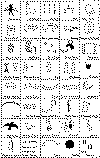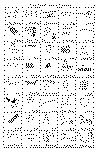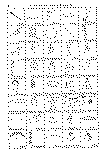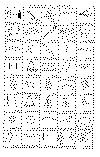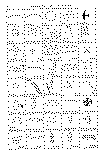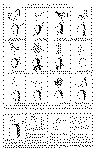By William Tomkins
PICTOGRAPHY AND IDEOGRAPHY OF THE SIOUX AND OJIBWAY TRIBES OF NORTH AMERICAN INDIANS
It is hoped that the following very brief treatise on the Pictographic writing of the American Indians, will excite interest in that branch of study by all boys and girls and others who are interested in anthropological research.
The attentions and investigations of the author have been for a long time devoted to pictography and to sign language, two studies so closely connected that neither can be successfully pursued to the exclusion of the other.
The depiction of gesture and posture signs is considered in more than a general way, showing the intimate relation between a thought as expressed without words by signs, and a thought expressed without words by pictures, sometimes corresponding to those signs.
Picture writing is a mode of expressing thoughts, or noting facts, by marks. It is one distinctive form of thought writing without reference to sound-gesture language being the earlier form. Picture writing should be studied as a phase in the evolution of human culture.
While not specifically reported in history it is thought from general evidence that writing preceded and generated the graphic systems of Egypt, Assyria and picture China, but in North America its use is still current. It can be studied here without interference or hypothesis, in actual existence, as applied to records and communications. In this connection it should be noted that picture writing is found in sustained vigor on this continent-the same continent where sign language has prevailed and has continued in active operation to an extent historically unknown in other parts of the world.
Petroglyphs, or rock carvings, are most frequently found in those parts of the world which are still, or recently have been, inhabited by savage or barbarian tribes, who, when questioned about the authorship of rock drawings, generally attributed them to supernatural beings. Man has invariably attributed to supernatural action whatever he did not understand.
Authorities are disagreed as to whether sign language, which is closely connected with picture writing, preceded articulate speech. It is sufficient to admit the undoubted antiquity of thought writing in both its forms.
Investigation has proven the interesting psychological fact that primitive or at least very ancient man made the same figures in widely separated regions, though it is not established that the same figures had a common significance. The modern specimens of picture writing shown on skins, bark and pottery, are far more readily interpreted than those on rocks, and have already afforded verification as to points of history, religion, customs and other details. American pictographs are not to be regarded as mere curiosities, but rather as representing the only intellectual remains of the early inhabitants, and bearing significantly upon the evolution of the human mind.
A knowledge of Indian customs, costumes, histories and traditions is, of course, essential to the understanding of their drawings. It is probable that many were intended to commemorate events which to their authors were of moment, but would be of little importance as history.
Though the picture writings do not, and probably never will, disclose the kind of information hoped for by some enthusiasts, they surely are valuable in marking the steps in one period of hum an evolution, and in presenting evidence of man's early practices.
The word signs presented in this work are of both ancient and modern American origin, and found either as petroglyphs, or rock carvings; petrographs, or rock writings; or as pictographs or writings on skins, bark, pottery, etc.
Petroglyphs and pictographs have been found and catalogued from the pyramids of Egypt to India, from Australia to Brazil, from Japan to Scotland, and in Mexico, and in many cases have handed down important traditional history of the times and peoples represented.
More distinctive examples of evolution in ideography and in other details of picture writing are found still extant among the Dakota (or Sioux) Indians, than among any other North American tribes.
The pictographic symbols used in this codification are taken from some of the most important known pictographs of the North American Indians. The classification and correlation of the matter collected has required more effort than is apparent, because the sources of information are so meager.
The more modern forms are explained by Indians who have kept up the pictographic practice, and these frequently throw light upon the more ancient.
This simple work is prepared for those men who desire brief, preliminary information on the subject, and does not assume to be anything further than that. During a series of lectures given by the author on sign language and pictography he was greatly impressed with the general lack of any knowledge on the subject, but most of all with the deep and kindly interest displayed by thousands of people in picture writing, which suggested the advisability of including a brief outline of some of the most generally used symbols.
Again, it is done in the hope that it will prove of interest and value to the youth of the United States, and develop in them an earnest desire for further study and research along this line.
Many of the pictographs herein contained are from the 10th annual report of the Bureau of American Ethnology, by Lieut. Col. Garrick Mallery, 1888, and from historical information of the Bureau of Indian Affairs, prepared by Henry R. Schoolcraft. 1851, and from other similar authoritative sources.
Longfellow was deeply interested in pictography, and gave the best and briefest description of nine symbols that has ever been compiled. It is given in the following verse from Hiawatha.
For the earth he drew a straight line,
For the sky a bow above it;
White the space between for day-time,
Filled with little stars for night-time;
On the left a point for sunrise,
On the right a point for sunset,
On the top a point for noontide,
And for rain and cloudy weather
Waving lines descending from it.
There is no doubt but that gesture language has had an immense use and value in the past. The question now arises as to whether or not its usefulness is gone. Has mankind so far advanced that he can entirely disregard the refinements of primitive man? As an argument to the contrary we might offer the following:
When the obelisk of Luxor was installed in Paris, and the best minds of that modern nation were called on to determine in what manner they should inscribe the record of the Paris of today, did they do it in the current French language? Did they do it in Greek or Latin? No, they inscribed it in primitive pictography, so that future generations countless thousands of years from now, when the French and Greek and Latin languages are gone and forgotten, can readily read the inscriptions made at this time.
